Antoine Vollon
Spring Flowers in a Green Vase
Dieppe
The Copper Basin
View of the Church of Notre Dame de Lorette and the Rue Flechier Paris
Still life with Lobster
Still life with Flowers and Ham
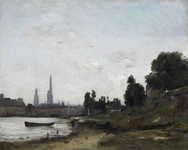
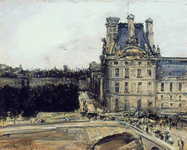
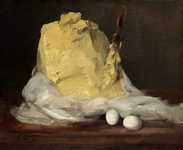

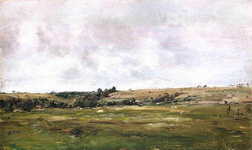
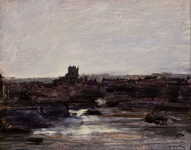


Fine Art Prints | Greeting Cards | iPhone Cases | Tote Bags | Clothing | Lifestyle | Beach ...
Antoine Vollon (April 23, 1833 – August 27, 1900)[1] was a French realist artist, best known as a painter of still lifes, landscapes and figures.[2] During his lifetime, Vollon was a successful celebrity,[3] enjoyed an excellent reputation, and was called a "painter's painter".[4] In 2004, New York's then-PaceWildenstein gallery suggested that his "place in the history of French painting has still not been properly assessed".[5]
Family and early years
Vollon was born the son of an ornamental craftsman in Lyon, France. He taught himself to paint. He began an apprenticeship to an engraver, and studied under Jehan Georges Vibert at the École des Beaux-Arts in Lyon to become a printmaker. He then worked at decorating enamelled pans and stoves.[2] In 1860 he and Marie-Fanny Boucher married and later had two children, Alexis and Marguerite.[6]
Paris and becoming a painter
In 1859 he moved to Paris, with the intention of becoming a painter. There he became a student of Théodule Ribot[7] and was influenced by Dutch still life painters of the 17th century. He became friends with Alexandre Dumas, Jean-Baptiste Carpeaux, Honoré Daumier and Charles-François Daubigny.[2] Vollon once described himself as a young artist "madly in love with painting".[5]
Figures and still lifes
Mound of Butter (1875–85; National Gallery of Art) was said to look so real that it might have been painted with butter itself.[8]
Vollon aspired to paint figures and not only still lifes which were the lowest acceptable genre for the Salon.[9] He submitted a figure painting of a woman carrying a large basket on her back, Femme du Pollet à Dieppe (Seine-Inferieure), to the 1876 Salon, where it won first prize[10] and received universally great reviews.[9] However it was criticised by Édouard Manet, who unleashed a few words, in English: Bah! What is Vollon's Femme? A basket that walks (French: Bah! . . . qu'est-ce que la Femme de Vollon? un panier qui marche) which stigmatized it. According to Carol Forman Tabler, curator and professor of art who wrote her dissertation on Vollon,[11] writing for Nineteenth-Century Art Worldwide:
“ "At a single blow, Manet's rapier wit exposed the still-life/figure paradox and Vollon was banished once again to an unshakable identity as a painter of still life."[9] ”
Later years and awards
Shoulder-high portrait of man in his sixties with short grey hair and beard wearing a suit
Portrait of Vollon in 1900 by Petit
Carol Forman Tabler wrote:
“ "Once Vollon began exhibiting at the Salon, he quickly gained recognition from the critics and the public at large, and, most importantly, from Second-Empire officialdom. He had learned how to play the political game that would earn him State patronage and enable him to win numerous awards...."[9] ”
Tabler describes his ambition and the decades-long strategies Vollon used to secure a place in history.[9] After one year in the Salon des Refusés in 1863, beginning in 1864 he exhibited his work at the Paris Salon. Vollon won a third-class medal in 1865, a second-class in 1868, and first-class in 1869.[9] Vollon was a member of the Salon's jury for at least ten years starting in 1870.[9]He also had students among which: Raymond Allègre (1857-1933), Henri Michel-Lévy (1845-1914) or Gustave Le Sénéchal de Kerdréoret (1840-1933).
He became a Chevalier of the Legion of Honor in 1870[9] and eight years later, received the Officer's cross.[7] He was elected to the Académie des Beaux-Arts in 1897. In 1900 he was awarded the Grand Prix at the Paris World's Fair.
In July 1900 he had a stroke while painting at Versailles and later caught a fever. He died in August and is buried in the Père Lachaise Cemetery.[6]
Legacy
Paris street with a restaurant in the foreground
A restaurant on Rue Antoine Vollon in Paris
Wildenstein showed more than 70 works by Vollon in Manhattan in 2004. For The New York Times, a reviewer wrote, "Vollon smacks too much of other artists to be Truly Important, but his sensuous wallows in paint are well worth wider notice".[8] But an earlier reviewer for the same newspaper quotes a critic writing in 1883, "He is, perhaps, the greatest painter living...."[4]
His son Alexis Vollon (1865–1945) became a painter.[12]
Two streets in France are named for him: Rue Antoine Vollon in Bessancourt and in Paris, whilst an intersection with a fountain in Lyon is named Place Antoine Vollon.
Gallery
Selected works
Dieppe, 1873
Vollon occasionally painted singeries (monkeys engaged in human activities).[8]
Still life
"La moisson"
Portrait of a man (1878)
Notes
Glasgow Art Gallery and Museum, compiled by Paton, James (1908). Catalogue, descriptive and historical, of the pictures and sculpture in the Glasgow art gallery and museum, Kelvingrove. R. Anderson via Google Books. p. 222.
"Antoine Vollon". Tate Collection. Retrieved January 1, 2011.
"Album de 500 célébrités contemporaines: Antoine Vollon". Musée d'Orsay. Retrieved January 4, 2010.
Russell, John (July 11, 1986). "Art: 'Liberty' Echoes 1883 Show". The New York Times. Retrieved January 1, 2011.
"Biography". Wildenstein. Retrieved January 1, 2011.
"Chronology". Wildenstein. Retrieved January 1, 2011.
Griscom, Clement A. (1914). Illustrated catalogue of the notable paintings. American Art Association via Google Books. p. 37.
Glueck, Grace (December 24, 2004). "Art in Review; Antoine Vollon". The New York Times. Retrieved January 1, 2011.
Tabler, Carol Forman (Autumn 2002). "Antoine Vollon and His Smashing Pumpkin: On Media Hype and the Meanings of Still Life". Nineteenth-Century Art Worldwide. 1 (2). Archived from the original on 13 December 2010. Retrieved January 1, 2011.
"Treasure Trove Gems from the collection". Gemeentemuseum Den Haag. Retrieved January 4, 2010.
"Carol Forman Tabler". Nineteenth-Century Art Worldwide. Autumn 2002. Retrieved January 1, 2011.
"Union List of Artist Names (ULAN): Antoine Vollon". Getty Research. J. Paul Getty Trust. Retrieved January 1, 2011.
----
Fine Art Prints | Greeting Cards | Phone Cases | Lifestyle | Face Masks | Men's , Women' Apparel | Home Decor | jigsaw puzzles | Notebooks | Tapestries | ...
----
Artist
A - B - C - D - E - F - G - H - I - J - K - L - M -
N - O - P - Q - R - S - T - U - V - W - X - Y - Z
Retrieved from "http://en.wikipedia.org/"
All text is available under the terms of the GNU Free Documentation License
Hellenica World - Scientific Library










